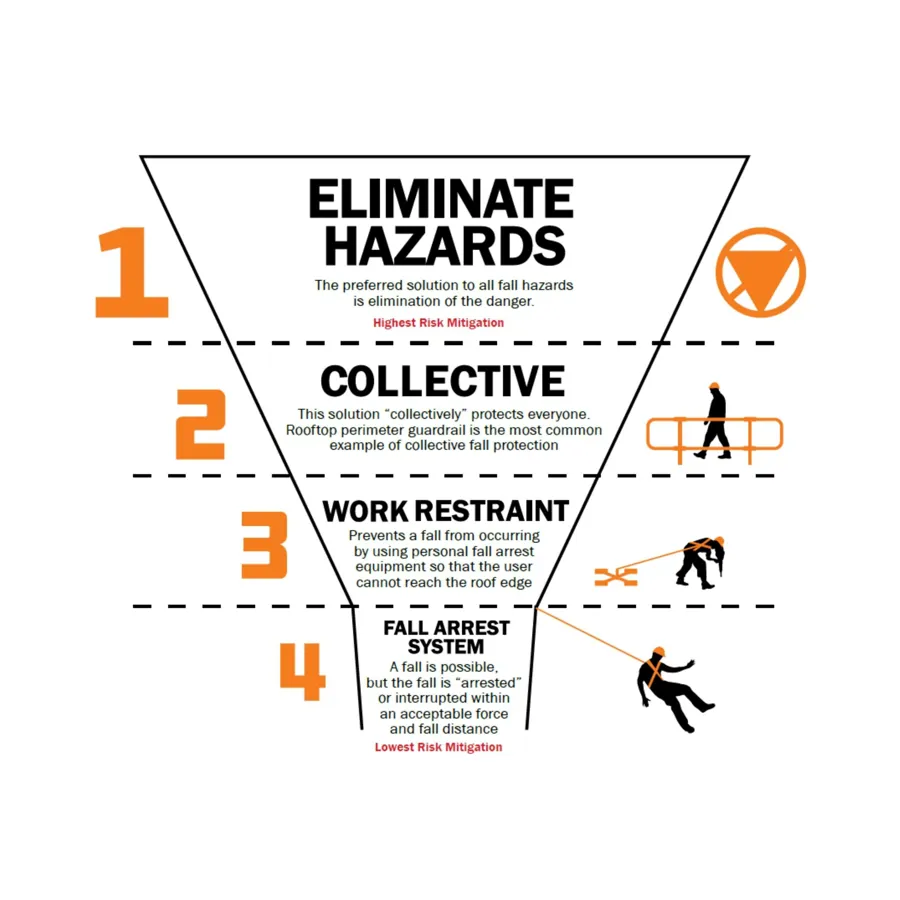
You are visiting the Canada Kee Safety website from United States. Would you like to go to the United States site?
With classrooms, dormitories, dining halls, offices, bookstores, sports and recreational facilities, and the physical plant, a college campus is a community unto itself. An elementary, middle, or high school has all or most of the above under one roof. Whether multiple or multi-use facilities, an educational institution faces many challenges in protecting its students and workers, especially rooftop fall protection.
According to EduRisk®, a study published by United Educators Insurance falls from heights represented 9% of reported claims yet 59% of monetary losses. Other slips and falls accounted for 18% of claims and 10% of losses. In total, slips and falls from height add up to 28% of claims and 69% of losses. These and other safety concerns need to be addressed on many levels.

Safety railings provide barriers and fall protection indoors and outside for several applications. They are used on stairs, walkways, mezzanines, loading docks, and the rooftop. They can keep crowds under control at events and help ensure that younger students waiting for the bus do not wander into harm’s way.
For corrosion resistance, either aluminum or galvanized steel railings are practical. Pipe-fitted, modular railings offer the versatility of permanent installation or reconfiguration for the changing needs of a school building or entire campus. Another advantage is that these component-based systems do not require any welding or drilling to put in place.

Equal opportunity despite physical limitations is an essential and required precept in education. Students and others who use wheelchairs need safe and ready access to buildings. Compliant access ramps with smooth handrails can help meet the grade.
Ramps should have a corrosion-resistant, anti-slip surface with an incline (or slope) of approximately 5 degrees. Railings with toeboards provide added protection, and smooth handrails are necessary. Pipe-fitted smooth handrails use internal couplings and cradle fittings for compliance
Contractors and staff maintenance workers access school rooftops to service equipment and perform repairs when needed. In addition to “collective” fall protection—safety measures in place to protect everyone collectively—professionals often use Personal Fall Arrest Systems (PFAS), such as horizontal lifelines or harnesses with lanyards and tie-offs to anchorages.
Although there can be public spaces on campus rooftops, such as a roof garden or balcony, it is, unfortunately, true that college students may gain unauthorized access to the roof. For dedicated workers and presumptive students, added fall protection measures are needed for roof access, roof edges, and roof openings.
The three most common ways to access a roof are from a stairwell, a ladder, and a roof hatch. A stairwell should have an internal handrail and a locked door, though other fall protection systems take over once on the roof. A ladder that leads to the roof needs a self-closing safety gate to safeguard the access point. Roof egress through a hatch must be protected by a roof hatch railing system that also includes a self-closing safety gate.

If a worker or wayward student comes within two meters of a roof edge, a perimeter railing system that meets regulatory standards (approx. 107 cm high and can withstand 91 km force) should be in place. As cited, this is a collective system to protect all workers at once. Another advantage is that a rooftop safety railing system requires virtually no training for the workers or students (who need to concentrate on their studies).
The greatest danger for students on the rooftop tends to be skylights, which are considered an opening in the roof. To protect students and workers, glass domes and skylights should be blocked off by safety railings or skylight screens.
Keeping students and workers safe is a priority of every school system. Colleges have started retrofitting dorms and eliminating balcony access; however, workers performing routine tasks on the roof must have fully compliant fall protection.
Although rooftops present the most apparent danger, safety solutions such as ground-based railings, wheelchair access ramps, and compliant handrails throughout the school or institution are also part of a comprehensive safety plan for educational facilities.

A truly comprehensive rooftop solution follows the Hierarchy of Fall Protection. An expert starts by inspecting the roof site for potential fall hazards. From there, a complete system solution and recommendations are created that descend down the four levels of the hierarchy, from simple, sensible approaches for eliminating risks all the way down to lifesaving personal protection systems.
Collective Systems require no additional training to use. Fall Restraint and Fall Arrest Systems both require a high level of user competency, training and additional inspection to be used properly.